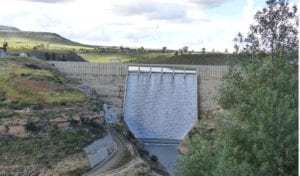Lesotho’s Metolong Dam has reached a major engineering milestone this year with dam spilling for the first time since it completion in 2016.
The $100-million dam was recently subjected to the full range of stresses it was designed for having reached full capacity with the dam’s spillway – meant to direct excess water downstream during flood periods – coming into operation. Metolong Dam Project Manager Beyers Havenga, a Technical Executive at GIBB, says that the spilling stage was the last test of the integrity of the dam following the construction phase of the project and the dam has passed it with flying colours. “Now we can say that the project was a success. It’s fulfilling its objective, which is to supply water to Maseru and environs for domestic use, as well as for economic development.”An innovative project
The 83m-high Metolong Dam is situated 30km east of Maseru and features a 280m-long crest, with a 75m spillway just below it. It is a roller-compacted concrete (RCC) gravity dam, with a total concrete volume of 315 000m3. It is designed to hold a capacity of 63 million m3 of water.The project was built using an innovative new concrete blend of Ordinary Portland Cement (OPC) and Pulverised Fly Ash (PFA), which improves workability, and reduces the temperature of the mixture when setting and helps to prevent cracking. The Metolong Dam project also comprises an intake tower, outlet works and a raw-water pump station.
“Despite only achieving capacity now, the dam has been yielding water for several years,” says Havenga. “The dam now delivers water to the water treatment works, which supplies Maseru and neighbouring towns like Mazenod, Morija, Roma and Teyateyaneng.







